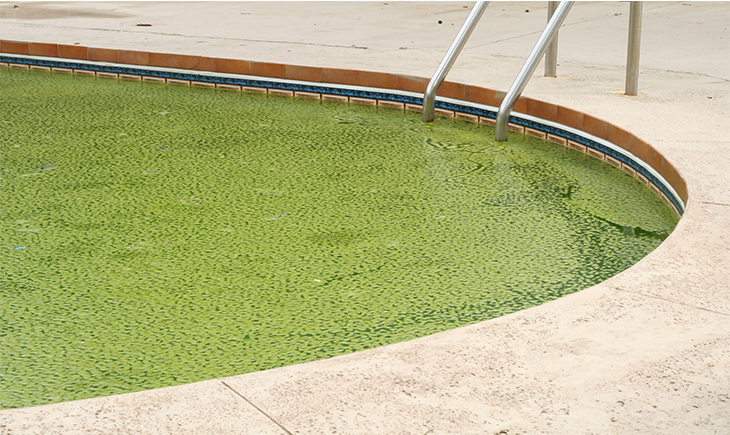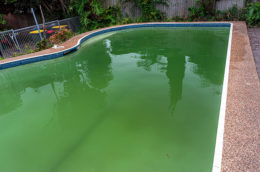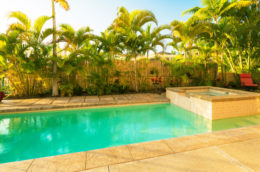
Why Is My Swimming Pool Water Turning Green?
Given the number of green pools out there lately, you would think they have become fashionable. But no one wants green pool water, and for good reason—it’s nasty. Still, no matter how hard you work at maintaining your pool water, sometimes it continues to turn green.
What to do?
First, realize that there can be two very different causes of green pools. Let’s look at each, and see what we can do to prevent them.
Algae
The first, and most common, cause for green pools is algae. Unless your pool is indoors, algae spores are always being deposited into your pool from the air and from rain. Runoff from the ground around your pool also washes spores from vegetation into your pool.
The organic debris that serves as food for algae comes from the same places. But we humans (and our water-loving pets) also contribute high levels of nutrients that algae need to grow in our pools. Hair- and skin-care products, sun screens, and cosmetics all disperse in pool water when we jump in, and these deliver high levels of nutrients to the water. We, and our pets, are also constantly shedding skin cells, which break down and supply nutrients to the water, contributing to algae growth and reproduction.
When algae populations are building in a swimming pool, the first sign is a greenish cast to what was, previously, blue water. If untreated, the water very quickly becomes greener and cloudy, as the algae population grows. The cloudiness occurs as algae colonies in the water grow large enough to scatter a significant amount of light passing through the water. At roughly the same time, visible green areas (more algae colonies) will appear on your pool steps, usually on the vertical faces first, or on the pool wall just below the water line. Algae colonies tend to attach to surfaces rather than remain free-floating. In nature, this provides a defense against some kinds of predation; in your pool it reduces the surface area of the algae colony that is exposed to potential sanitizing attack.
The remedy is simple. First, make sure your filter is clean and functioning properly. Then shock your pool water with chlorine and use a pool brush to remove algae from the pool wall and all step surfaces. After letting your pump operate for a full cycle, usually 8 hours over the course of a 24-hour day, clean out your filter. This is where the algae (the living and the dead) will have collected. With the filter clean and the chlorine level in the proper range (0.6 – 3.0 ppm is typical), balance the water. You will probably need to adjust the water’s total alkalinity and pH in order to get them into recommended ranges. You may also need to raise the water hardness to the proper level, as well.
If algae blooms reoccur, then you should consider using a copper-based algicide, and possibly a phosphate remover. The algicide, of course, is designed to kill algae before they start reproducing rapidly. Many pools exhibit high phosphate levels, which also contribute to algae growth. Phosphates arrive in pool water from a variety of sources, including both natural and manmade sources. Natural sources include like plant and insect debris. Manmade sources include chemicals used by municipal water treatment facilities and residential fertilizers.
We recommend 90-Day Algicide and Lo-Phos® Max by Lo-Chlor® for treating these problems.
Dissolved Metals
The second cause of green pools is excess dissolved metal (usually copper) in the pool water. Dissolved metal is indicated by water that is unclouded, yet tinted green.
Since the water is clear, you might be tempted to ignore the green hue of dissolved metal present in your pool. However, failing to treat this condition will result in green copper stains appearing on pool surfaces. Treatment is simple, and requires only the addition of a metal sequestrant. This is a material that binds metals so that they are not free to deposit onto surfaces and to stain them. An addition of a good metal sequestrant like Metal Gone or FastStart-Tech™ by Lo-Chlor will quickly remove the tint.
If there are already stains on your pool surfaces, or if the green tint reoccurs, you should find and permanently remove any obvious sources of metal contamination. Sources might include copper pipes or fittings, or, perhaps, old pool water heaters/heat pumps with copper-nickel components.
Once you have eliminated the source of metal stains, there are two ways you can remove the stains. One method is to hire a professional pool service to acid-wash the pool surfaces. This chemical treatment is expensive, but, in severe cases, it may be the only option short of resurfacing the pool. The other method is to apply a pool stain-removing product available at your local pool products store. One of the most effective and possibly the easiest to use is Lo-Chlor Multi-Stain Remover. This product is inexpensive, it removes every type of stain so that there is no need to determine which type of stain is involved, it works quickly on both spot stains and broad discolored areas, and it doesn’t require that you drain your pool.
Once your pool water is no longer discolored and any stains have been removed, you’ll need to bring your pool chlorine to appropriate levels and rebalance the water. And just how do you balance your pool water? Blog on that subject coming soon! Leave us a comment, we love to hear from you!




This Post Has 0 Comments